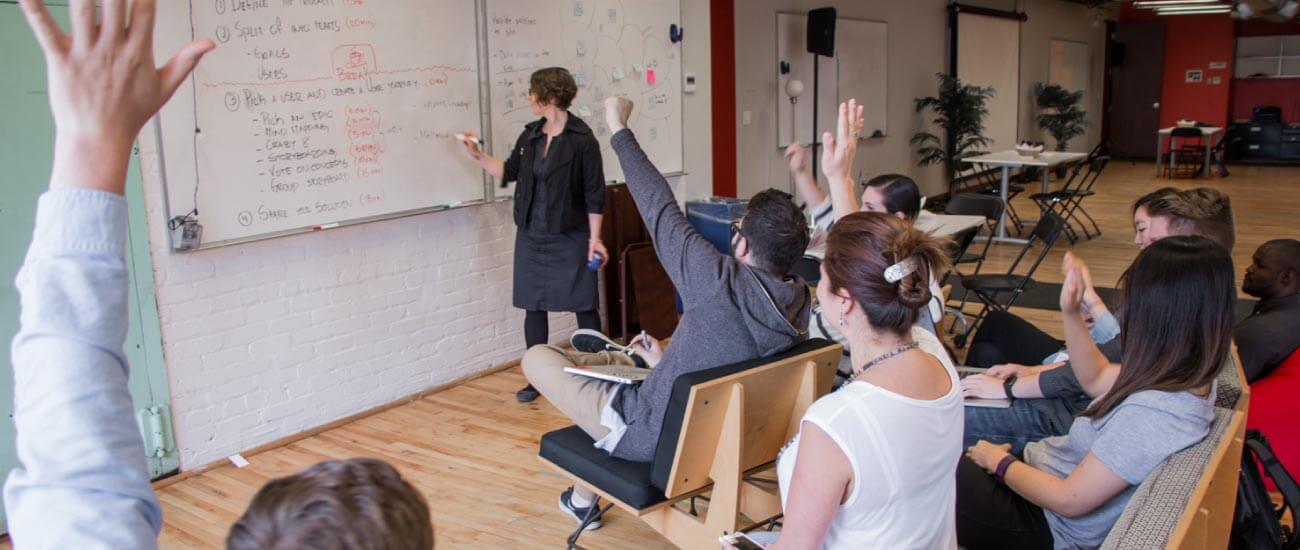We don’t often think of facilitation as a core skill for product designers, but there are many reasons why we should. One is that a lot of the design discovery that we do is like detective work. To design great products, you need to tease out and gather information from a wide variety of people, starting with the stakeholders on your project.
“To extract the most information you can from your client, you must ask questions. Lots of questions. Think of it like playing detective, gathering clues and working to understand the players in the game.”
— Janice Gervais, A List Apart
Tracking down these clues — and effectively sharing that intel with your team — can make or break a project. Without asking questions and doing this detective work, your team won’t have the context necessary to make the project a success. This context includes: why you’re building this product, who it’s for, how it helps those people, and what project success looks like to each of your stakeholders.
One of the most effective ways to do this detective work is by facilitating your project kickoff and design discovery sessions, and continuing to facilitate similar discussions throughout the life of your project.
A Quick Overview of Facilitation
Whether you’re completely new to facilitation, or just need a quick refresher, here are some key concepts to keep in mind.
What do we mean by ‘facilitation’?
To facilitate something basically means to make it easier, or to help it move forward.
In the context of meetings or group discussions, facilitation helps the group “traverse a problem space”[^1] through a series of structured activities, a playbook of exercises “to open, explore, and narrow focus on the problem.”[^2] Examples of these include the diverge-converge, heatmap generation, and note-and-vote exercises that we use as part of our project kickoff activities at Rangle — like our Clarity Canvas.
Why do groups need facilitation?
Group discussions need the help of structured, facilitator-led activities because their natural dynamic “often leads to awkward disagreements and dead ends. Solid facilitation methods help you move around, over, or through these situations.”[^3]
During kickoff sessions, using techniques like Rangle’s Clarity Canvas, facilitation helps stakeholders align on the project’s key goals and outcomes, and gives the team a shared understanding about the problem they’re trying to solve.
What’s your role as a facilitator?
As a facilitator in a project kickoff session, your role is to help guide the group through the activities and collaborative work they need to do. “A good facilitator ‘support(s) everyone in doing their best thinking’ during a meeting — they build and execute participatory processes.”
So while facilitation is a lot of work, your main role in kickoff sessions is to enable the project team’s contributions — not to be directly involved in coming up with solutions. “Facilitating is more about listening to the conversation... than actively participating in it... as a facilitator, [it’s important to] let the participants generate the content on their own.”
It also means guiding or directing conversations and activities, rather than leading them. Respecting the difference between these is crucial to successful facilitation: “Leading is taking the reigns and potentially pushing participants in a single direction. Directing [or guiding] encourages the participants to move in a direction that makes sense to them.”[^4]
Acting as a guide means you allow solutions to come from the project team. This is key to ensuring that the outcomes and priorities established in the discovery session have their full support, and that you’ll be defining solutions that the team is fully invested in. Remember, the group is doing this work in order to arrive at the alignment and shared understanding that they need to hit the ground running — in the right direction, and as a team — immediately after kickoff.
What makes a good facilitator?
We’ve already covered two key qualities to being (or becoming!) a good facilitator: enabling the team’s contributions, and guiding participants instead of leading them. Here are a few more, which anyone can develop with practice:
- Empathy: While facilitating, you express empathy by listening to and supporting a “diverse range of people and personalities.”
- Enthusiasm: “Creating and maintaining the energy of a session is no small task... The facilitator needs to be the source of this momentum, from start to finish.”
- Diplomacy: Participants in a kickoff session are highly invested in and passionate about the project you’re discussing. Passion can drive engagement, but can also “take a productive conversation and turn it into an argument. Facilitators need to manage these situations appropriately and maintain a safe and positive environment for all participants.” Being diplomatic also means taking a polite-but-firm stance on time-boxing , to respect participants’ time and keep the session running smoothly.
- Patience: That said, sometimes you’ll need to counterbalance conscientious time-boxing with patience, since it takes time for participants to arrive at alignment and shared understanding. “A proficient facilitator does not try to rush participants to a solution or resolution too fast.”[^5]
- Flexibility: This is an important skill in many scenarios, like knowing whether to stick closely to the schedule, or whether a discussion is worth lingering on. Successful facilitators are also comfortable switching from one tool or technique to another, based on the group dynamic and how the session is unfolding. While you’re developing these skills, there are exercises you can use to work through these types of situations. (More on those in an upcoming blog post.)
- Active Listening: Listening closely to what participants are saying is a key part of any kickoff session — but you’ll also need to summarize what they say in a way that clarifies that information for the group, and distills the key insights. Paying attention to participants’ body language and tone of voice is important here, too: successful facilitators are attuned to the group’s nonverbal communication cues, and know how and when to respond to them.
- Critical Thinking: As a facilitator, you’ll need to think on your feet; developing your critical and analytical skills will help you do that. You’ll put these skills to good use by identifying when you need to ask more questions to draw out details, clarifications, and insights from the group.
To be clear: critical thinking doesn’t mean criticizing or pushing back on the group’s contributions or insights. Instead, it means developing a spidey-sense for when to do more sleuthing, and how to dig deeper with your questions.[^6]
Facilitation and Product Design
Investing time and effort into honing your facilitation skills pays dividends throughout the life of your project. If you’re on a product team, or you work with the same client again, you’ll also see this payoff continue after the project ends.
By successfully facilitating project kickoff with your stakeholders, you’re building trust with them. As our Product Design Lead, Mike Costanzo wrote in a recent blog post, you do this by showing stakeholders that “you understand and are committed to the same outcomes as they are, that you want and need to understand their business and customer objectives and that you’re willing to do the work to make this happen... Your stakeholders have pains and goals. Your job is to alleviate those pains and help them achieve their goals.”[^7]
Building this level of trust with stakeholders helps them see you as a partner in achieving the outcomes they want — on their team, in their company, for their customers, in the world — instead of just the provider of a service called “design”. [^8]
"To be involved in strategy is to be involved in the why — the identification of real problems, the prioritization of which of those problems are most pressing to solve right now."
— Julie Zhuo
Running effective project kickoff and design discovery sessions lets you shift the dynamic in powerful ways for your stakeholders, for the project team, and for yourself as a designer. Instead of simply being handed the “what”, and being tasked with designing and building that thing, you start out by delving into the “why”. Being involved in defining the “why” gives you the superpowers you’ll need to shape the direction of a product in a more meaningful way.
Sounds great, doesn’t it? But first, you’ll need to up your facilitation game. Facilitating can be an intense and challenging experience. The good news is that it’s a completely learnable skill — whether you’re an introvert, extrovert, or somewhere in between.
Level up your facilitation skills
In the near future, we’ll be writing about this process in detail on the Rangle blog, including:
- How to facilitate a project kickoff session using Rangle’s Clarity Canvas, with all the nuances that involves
- How we’re scaling Clarity Canvas across the organization
- How it’s worked on real projects (warts and all)
If this sounds interesting, check back often, or follow us on Twitter (we always post blog updates there).
Learn more
Have questions about how our design process can be applied to your e-commerce web or mobile project? Contact us to learn more about strategies that have worked for retail clients including Aldo, Uniqlo and Priceline.
[^1]Brad Ty Nunnally, UX Magazine
[^2]Kevin M. Hoffman, A List Apart
[^3]A List Apart
[^4]All quotes in this section are from UX Magazine; emphasis added.
[^5]Quotes in this section and the list of qualities prior to “Flexibility” are from UX Magazine.
[^6]Edward Glaser, The Critical Thinking Community
[^7]Mike Costanzo, blog.rangle.io
[^8]Julie Zhuo, Medium

